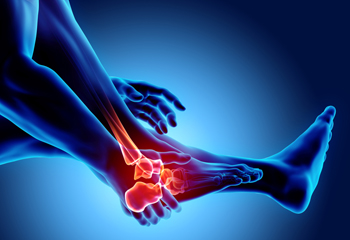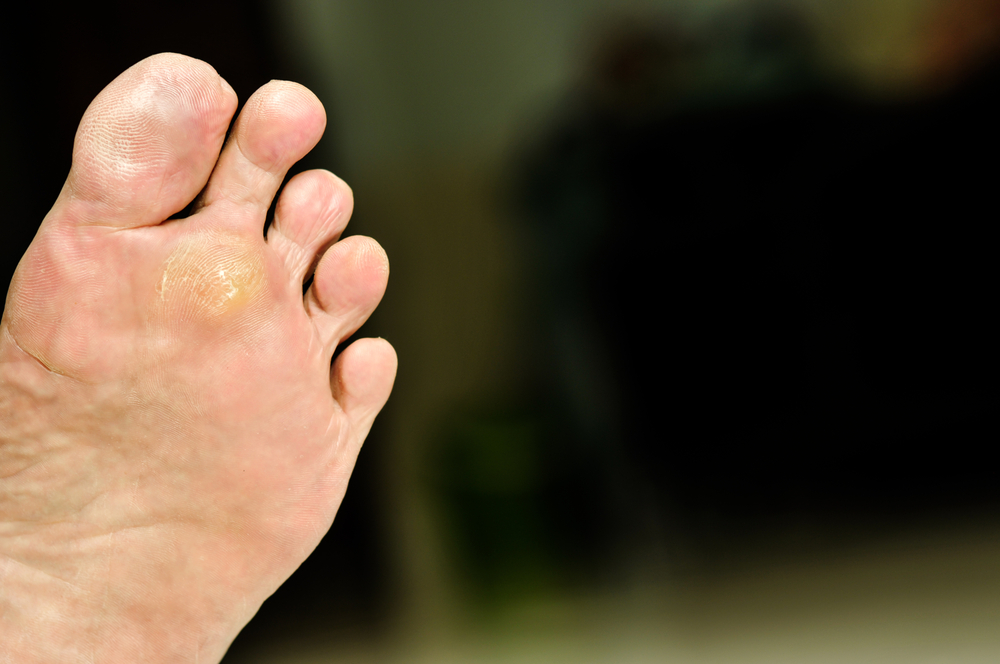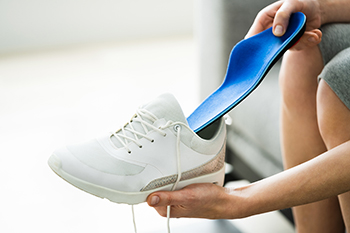Connect With Us
Blog

Athlete’s foot, known medically as tinea pedis, is a common fungal infection that affects the skin between the toes and along the foot. It is especially prevalent among football players due to warm, moist environments inside cleats and frequent shared locker room spaces. Symptoms often include itching, burning, peeling skin, and a persistent rash. The condition develops when fungus thrives on damp skin, often worsened by sweat, wearing tight footwear, or walking barefoot in communal areas. A podiatrist can diagnose the infection, recommend effective antifungal treatments, and provide guidance on prevention to stop it from returning. If you have symptoms of athlete’s foot, it is suggested that you schedule a visit with a podiatrist for effective relief, treatment and prevention tips.
Athlete’s foot is an inconvenient condition that can be easily reduced with the proper treatment. If you have any concerns about your feet and ankles, contact Dr. Howard Horowitz from Bowie Foot & Ankle . Our doctor will treat your foot and ankle needs.
Athlete’s Foot: The Sole Story
Athlete's foot, also known as tinea pedis, can be an extremely contagious foot infection. It is commonly contracted in public changing areas and bathrooms, dormitory style living quarters, around locker rooms and public swimming pools, or anywhere your feet often come into contact with other people.
Solutions to Combat Athlete’s Foot
- Hydrate your feet by using lotion
- Exfoliate
- Buff off nails
- Use of anti-fungal products
- Examine your feet and visit your doctor if any suspicious blisters or cuts develop
Athlete’s foot can cause many irritating symptoms such as dry and flaking skin, itching, and redness. Some more severe symptoms can include bleeding and cracked skin, intense itching and burning, and even pain when walking. In the worst cases, Athlete’s foot can cause blistering as well. Speak to your podiatrist for a better understanding of the different causes of Athlete’s foot, as well as help in determining which treatment options are best for you.
If you have any questions please feel free to contact our office located in Bowie, MD . We offer the newest diagnostic and treatment technologies for all your foot and ankle needs.

Osteoarthritis in the ankles often begins with a deep, aching pain around the joint that becomes more noticeable during movement or after standing for long periods. Stiffness can make it difficult to bend the ankle fully, especially after rest, and swelling may develop on one side or all around the joint. Tenderness when the ankle is touched or squeezed is another sign of osteoarthritis, and walking can become challenging as the joint loses flexibility. When cartilage in the ankle joint wears down and the protective space between the bones narrows, bone spurs can form and lead to increased pain with each step. Shoes that lack adequate support or frequent use of flip-flops can place extra stress on already irritated tissues. A podiatrist can evaluate ankle motion, check for swelling, order and review imaging, and recommend the best treatment to reduce symptoms. If you have symptoms of osteoarthritis in the ankles, it is suggested that you make an appointment with a podiatrist for a diagnosis and treatment.
Arthritis can be a difficult condition to live with. If you are seeking treatment, contact Dr. Howard Horowitz from Bowie Foot & Ankle . Our doctor can provide the care you need to keep you pain-free and on your feet.
Arthritic Foot Care
Arthritis is a joint disorder that involves the inflammation of different joints in your body, such as those in your feet. Arthritis is often caused by a degenerative joint disease and causes mild to severe pain in all affected areas. In addition to this, swelling and stiffness in the affected joints can also be a common symptom of arthritis.
In many cases, wearing ill-fitting shoes can worsen the effects and pain of arthritis. Wearing shoes that have a lower heel and extra room can help your feet feel more comfortable. In cases of rheumatoid arthritis, the arch in your foot may become problematic. Buying shoes with proper arch support that contour to your feet can help immensely.
Alleviating Arthritic Pain
- Exercises that stretch the foot can prevent further pain and injury and increase mobility
- Most of the pain can be alleviated with anti-inflammatory drugs, heat, and topical medications
- Massages can help temporarily alleviate pain.
It is best to see your doctor for the treatment that is right for your needs and symptoms. Conditions vary, and a podiatrist can help you determine the right method of care for your feet.
If you have any questions please feel free to contact our office located in Bowie, MD . We offer the newest diagnostic tools and technology to treat your foot and ankle needs.

Plantar warts are small growths on the soles of the feet caused by the human papillomavirus, or HPV, which enters the skin through tiny cuts or abrasions. They are commonly found on weight bearing areas, such as the heels or balls of the feet. A plantar wart may appear as a rough, grainy patch with small black dots, which are tiny blood vessels. They can feel painful or tender, especially when walking or standing for long periods, and some may cause a feeling of pressure, like walking on a small pebble. Plantar warts are more common in children and young adults, and they can spread through direct contact with contaminated surfaces like locker rooms or swimming pool areas. A podiatrist can evaluate the lesion to confirm the diagnosis and rule out other conditions. Treatments may include topical therapies or minor surgical removal. Early intervention helps reduce discomfort and prevent spreading. If you notice persistent growths on your feet, it is suggested that you make an appointment with a podiatrist.
Plantar warts can be very uncomfortable. If you need your feet checked, contact Dr. Howard Horowitz from Bowie Foot & Ankle . Our doctor will assist you with all of your foot and ankle needs.
About Plantar Warts
Plantar warts are the result of HPV, or human papillomavirus, getting into open wounds on the feet. They are mostly found on the heels or balls of the feet.
While plantar warts are generally harmless, those experiencing excessive pain or those suffering from diabetes or a compromised immune system require immediate medical care. Plantar warts are easily diagnosed, usually through scraping off a bit of rough skin or by getting a biopsy.
Symptoms
- Lesions on the bottom of your feet, usually rough and grainy
- Hard or thick callused spots
- Wart seeds, which are small clotted blood vessels that look like little black spots
- Pain, discomfort, or tenderness of your feet when walking or standing
Treatment
- Freezing
- Electric tool removal
- Laser Treatment
- Topical Creams (prescription only)
- Over-the-counter medications
To help prevent developing plantar warts, avoid walking barefoot over abrasive surfaces that can cause cuts or wounds for HPV to get into. Avoiding direct contact with other warts, as well as not picking or rubbing existing warts, can help prevent the further spread of plantar warts. However, if you think you have developed plantar warts, speak to your podiatrist. He or she can diagnose the warts on your feet and recommend the appropriate treatment options.
If you have any questions, please feel free to contact our office located in Bowie, MD . We offer the newest diagnostic and treatment technologies for all your foot care needs.

Orthotics can be an effective solution for anyone with flat feet because they provide stability, support, and improved alignment. Customized orthotics are often better than standard inserts because they are created to match both typical and atypical foot structures. They can be adjusted over time to ensure continued comfort as your needs change. Proper support can reduce pain in the feet, ankles, knees, and lower back, making daily activities more comfortable. A podiatrist can evaluate your foot structure, recommend the right type of orthotic, and make any needed modifications for the best results. If you have discomfort from flat feet or want better support, it is suggested that you schedule an appointment with a podiatrist to explore personalized orthotic options.
If you are having discomfort in your feet and would like to try orthotics, contact Dr. Howard Horowitz from Bowie Foot & Ankle . Our doctor can provide the care you need to keep you pain-free and on your feet.
What Are Orthotics?
Orthotics are inserts you can place into your shoes to help with a variety of foot problems such as flat feet or foot pain. Orthotics provide relief and comfort for minor foot and heel pain but can’t correct serious biomechanical problems in your feet.
Over-the-Counter Inserts
Orthotics come in a wide variety of over-the-counter inserts that are used to treat foot pain, heel pain, and minor problems. For example, arch supports can be inserted into your shoes to help correct overarched or flat feet, while gel insoles are often used because they provide comfort and relief from foot and heel pain by alleviating pressure.
Prescription Orthotics
If over-the-counter inserts don’t work for you or if you have a more severe foot concern, it is possible to have your podiatrist prescribe custom orthotics. These high-quality inserts are designed to treat problems such as abnormal motion, plantar fasciitis, and severe forms of heel pain. They can even be used to help patients suffering from diabetes by treating foot ulcers and painful calluses and are usually molded to your feet individually, which allows them to provide full support and comfort.
If you are experiencing minor to severe foot or heel pain, it’s recommended to speak with your podiatrist about the possibilities of using orthotics. A podiatrist can determine which type of orthotic is right for you and allow you to take the first steps towards being pain-free.
If you have any questions, please feel free to contact our office located in Bowie, MD . We offer the newest diagnostic and treatment technologies for all your foot care needs.
